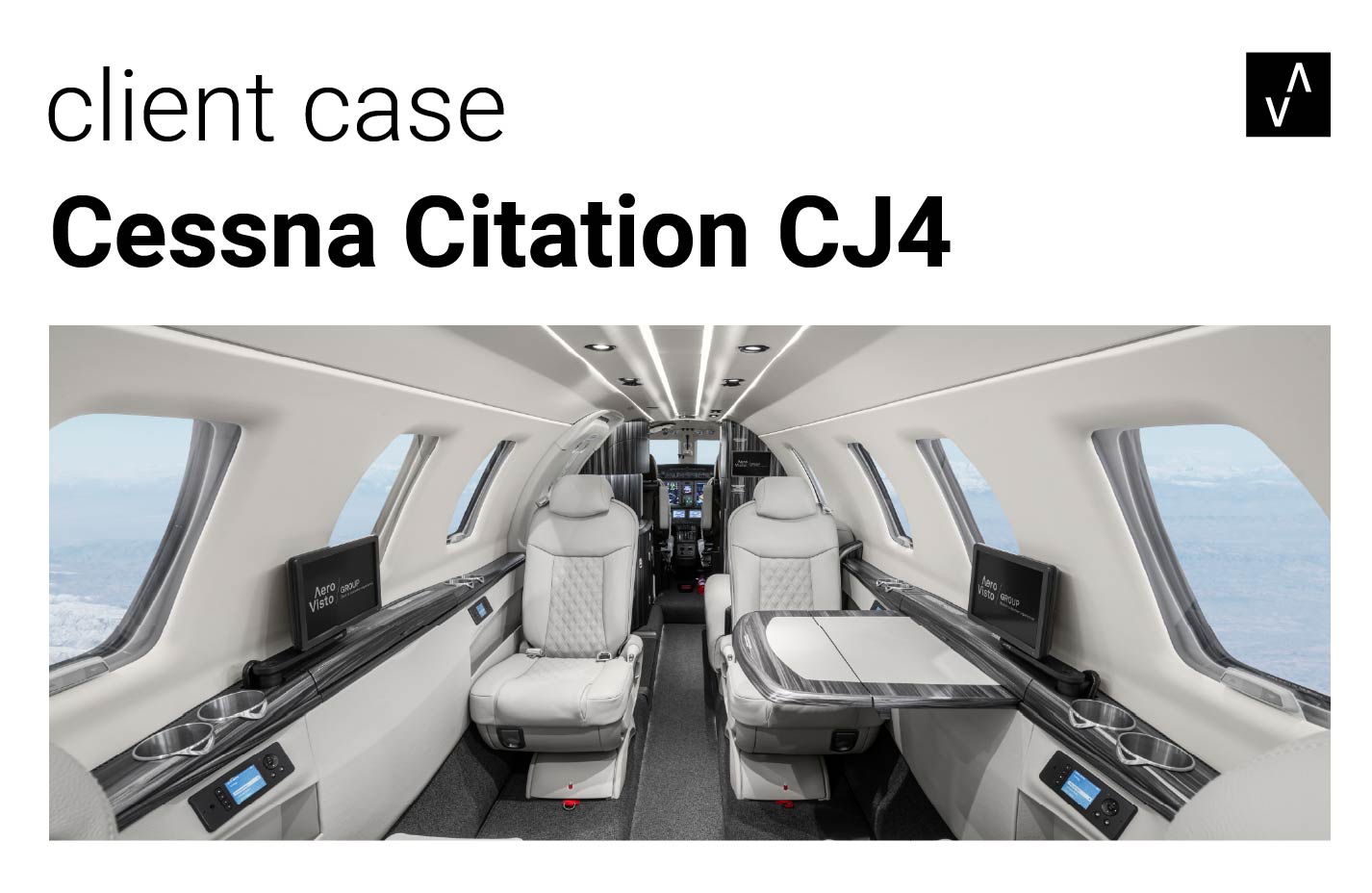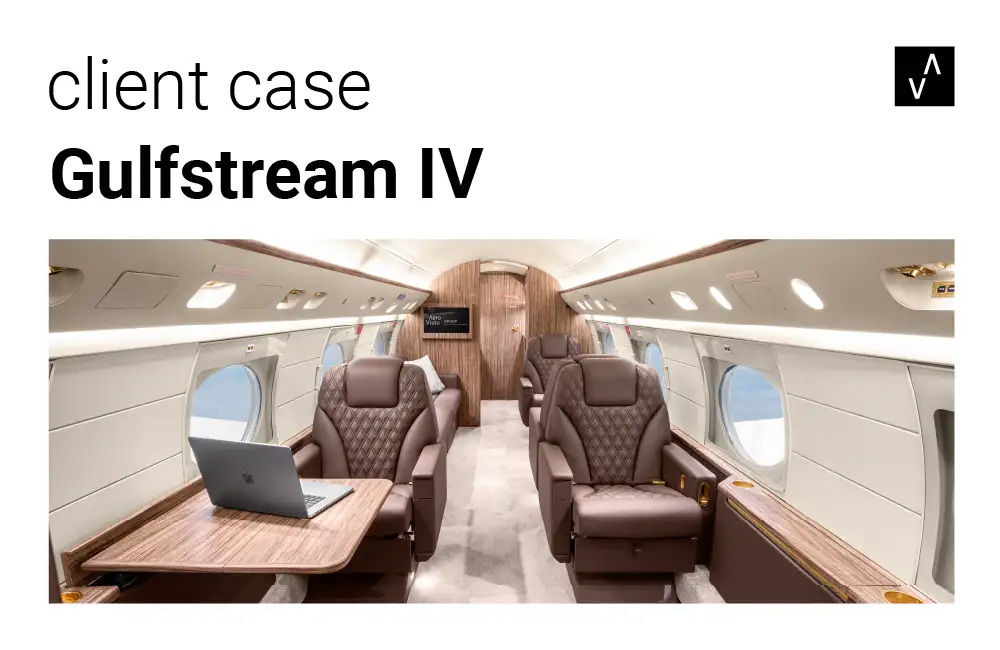
Client Case: Cessna Citation CJ4
Understanding that successful interior design begins with careful material selection, our team conducted the initial consultation in a private atmosphere at the client’s preference.
We spoke with Hermann Bauer about the development of AeroVisto’s pioneering Decor Film Application technology, which has now been proven across more than 150 aircraft.

Hermann, take us back to that moment in 2017. What made you look beyond conventional solutions?
HB: The situation was quite clear. We had a client with a Cessna CJ1 with gray-painted wood who wanted a wood-look finish. When I quoted the traditional refinishing price for that small pile of parts, his first reaction was basically “you must be crazy.” That reaction made me think – there had to be a better way.
Almost simultaneously, Andreas Sperber from VistaJet inquired about offering alternatives to traditional refinishing. That motivated me to explore beyond aviation, where I discovered professional-grade decorative films with impressive capabilities that hadn’t yet been adapted for aircraft interiors.
What happened next? How did you bridge the gap between this discovery and aviation application?
HB: That’s where the real work began. I spent the next year in development, with six months of that time dedicated to an intensive testing phase. We had to develop a complete system. The film itself is just one component – we needed special surface preparation, application techniques, and a protective coating on top. Everything had to work together perfectly.
We built test samples and conducted the same fire tests we do for veneer and paint. We collaborated with film professionals from Switzerland and Germany, who had extensive experience. They showed us methods and techniques that we further refined for use in aviation. Every test was successful – including fire tests and pre-burn tests on various substrates, such as honeycomb panels. That gave us confidence.
When were you ready to move from testing to implementing this on an actual aircraft?
HB: By fall 2018, we were ready. I assembled a team of professional film applicators for the first aircraft. It wasn’t just any small jet – it was a Challenger 850 for VistaJet. The project was a complete success. VistaJet was so impressed that they’ve since converted their entire fleet to film application. They no longer paint – everything is filmed.
What’s the difference between simply applying film and doing it properly?
HB: Professional applicators will tell you – you have to feel the soul of the material. It means knowing the exact limits – how far you can stretch the film around curves, when the wood grain pattern starts to distort, where problems might develop. These are often hard boundaries that change quickly. You need to know them.
It also requires extreme patience. The film must be worked like real veneer – considering grain direction, ensuring patterns match across cabinet doors and drawers. The final result must look as cohesive as traditional veneer work.
“You have to feel the soul of the material!”
After seven years of proven success, you must have attracted competition, right?
Yes, definitely. We’ve seen competitors emerge – first in the USA, then others followed. But we see it in the images customers send us – bubbling, lifting edges, film falling off. When I look at these failures, I know exactly what went wrong. The competitors think it’s simple: take film, apply it to a sanded surface, done. They treat it like a simple DIY project, thinking “anyone can apply film.
But they’re missing the complete process. How must the surface be prepared? How do you treat edges and corners to prevent moisture ingress? What post-application treatment is needed? We’ve spent seven years refining every detail. We’re not just better – we’re several steps ahead because we never stopped improving.
"We're not just better – we're several steps ahead because we never stopped improving."
Your 5-year warranty is unique in the industry. How is that possible?
HB: We have absolute confidence in our system. Traditional painting or veneering comes with a 6-12 months warranty at best. We offer a five-year guarantee because we know our process works.
The key is our complete system approach. We’ve eliminated typical failure points through our specialized preparation process, application technique, and protective coating applied on top of the film. After seven years and over 150 aircraft, we’ve proven this system works in real flight conditions – temperature extremes from -30°C to +80°C, pressure changes, and humidity variations.
The film material itself, once properly applied and sealed with our process, is highly durable. When customers ask, “Doesn’t it scratch more easily than lacquer?” – the answer is no. In fact, it’s more resistant, especially when we use specialized films designed for high-traffic areas. If you scratch traditional lacquer with your watch, you have damaged it. The same applies to Décor Film Applications – but the critical difference is that we can repair it quickly and locally.
That’s what gives us the confidence to offer a five-year guarantee. We know the material, we’ve perfected the process, and we’ve seen the long-term results in service.
"We have absolute confidence in our system... We offer a five-year guarantee because we know our process works."
What about ongoing maintenance? How does film compare to traditional finishes?
HB: This is a huge advantage that our operators particularly love. Imagine a door frame at the aircraft entrance where moisture causes veneer to lift or lacquer to crack. Every passenger sees it – charter clients, owners, everyone complains.
Traditionally, you’d need to remove the part, send it to the shop, strip it, refinish it, and apply multiple coats, with a drying time in between each coat. That’s up to two weeks of downtime just for one damaged part.
With film, I send someone with the right material from our stock. They remove the old film, apply new film, and it’s done in one day. The aircraft is back in service immediately — no workshop, no long refinishing process, no extended downtime.
This flexibility is invaluable for charter operators who can’t afford to have aircraft sitting on the ground. Even private owners appreciate being able to fix issues quickly between trips rather than planning extended maintenance windows.
What do customers say when they see the finished result?
HB: This is what really surprises people. The film provides industrially manufactured perfection – no dust particles, no runs, no imperfections that hand-applied finishes often have. When a craftsman applies lacquer, no matter how skilled, there’s always the human factor. Our film comes perfect from the factory.
I’ve seen customers inspect traditional lacquer work with flashlights and mirrors, finding every tiny flaw. But with Decor Film Application, they’re amazed – the surface is flawless. It’s exceptionally motivating for our team too, because their work isn’t picked apart for minor imperfections that are inevitable with hand-applied finishes.
You offer both film and traditional veneer options. How do you help clients understand which solution best fits their needs?
HB: I always say, ‘If you want real wood, choose real wood.’ However, make sure you can actually feel and possibly even smell the wood in your aircraft. When wood is covered with 15 layers of high-gloss or matte lacquer, you’re essentially touching plastic anyway – just like our film.
For clients who want that high-gloss piano finish, we clearly recommend traditional lacquer – that’s currently not possible with film. However, if they prefer the contemporary matte finish, which is very fashionable now, I often recommend that they look at our “Drywood” film options. The texture and appearance are so authentic that I regularly demonstrate this: I show clients a surface and ask, “How do you like this wood?” They say it looks great, even comment that it smells like wood – and I absolutely understand why they perceive it that way. The quality has reached a level where the sensory experience is nearly identical. When I then mention it’s actually film, they’re genuinely surprised, but more importantly, they realize that their initial positive reaction is what matters most.
What’s fascinating is that premium hotels, airports, and luxury spaces worldwide have already embraced this technology. The next time you’re traveling, you may notice these beautiful wood surfaces that create such warm and inviting environments. Many of these are advanced films, chosen by world-class designers for their beauty, durability, and consistency. It shows how the technology has matured to meet the highest standards.
However, at AeroVisto, we’re not tied to a single solution. We’re pragmatic – we recommend whatever serves the client’s best interests. And in aviation, Decor Film Application consistently creates win-win situations for all parties involved.
"The quality has reached a level where the sensory experience is nearly identical."
Can you share a specific example of these win-win situations?
HB: Certainly. We recently had a project where this became very clear. The designer had created a beautiful concept with a complete wood change for the cabin, but when we quoted traditional veneering, the client said no – too expensive. In our market segment, this happens frequently. Price and time often force clients to simply repaint their existing surfaces, which means designers can’t truly transform the cabin’s character.
But in this case, we proposed our film solution as an alternative. The price came down significantly, the timeline was cut in half, and suddenly the project was viable. The designer could realize their complete vision, the client got exactly the transformation they wanted at a reasonable cost, and we had the opportunity to deliver another beautiful interior. Everyone won.
This has happened multiple times now. Decor Film Application opens doors that would otherwise remain closed, enabling creative designs that might never have seen the light of day with traditional methods alone.
Designers seem to be important partners in what you do. What role do they play, and what’s your message to them?
HB: Designers are crucial partners for us. They’re often the ones who push boundaries and see possibilities beyond conventional solutions. They also face the challenge of balancing client dreams with budget realities.
My message to them is simple: Come explore Decor Film Application with us. Let us show you samples. Bring us your ideas and let’s discuss how to bring them to life with film. We can even combine film with traditional lacquer and veneer in the same interior. So, open yourselves to this possibility because ultimately, it brings value to everyone. The client gets what they want, designers get their projects realized, and we deliver exceptional quality. There are solutions beyond traditional methods.
Where do you see this technology heading?
HB: We’re far from finished. In our headquarters in Staad, we’re setting up a creative space where our applicators can experiment with combining different films – wood with gold, silver inlays, carbon, stone effects. We want to show designers they don’t need to use one film for the entire cabin. We can work with five or six different films on different substrates, creating unique combinations that push the boundaries of what’s possible.
AeroVisto is also developing new solutions – including an intermediate option between traditional veneer and film. While the fire testing is more complex, this shows our openness to new technologies and approaches. We’re not bound by tradition; we embrace whatever serves our clients best.
Looking at aviation specifically, I see film technology becoming increasingly sophisticated and widely accepted. We’re already seeing interest from OEMs and completion centers. As more operators experience the benefits – the time savings, cost efficiency, and maintenance advantages – adoption will accelerate. The technology will continue to evolve, offering even more options for aircraft interiors.
The logical next step would be for OEMs to offer film as an option right from the factory, alongside traditional finishes. When that happens, it will simply be an accepted standard in aircraft specifications.

Understanding that successful interior design begins with careful material selection, our team conducted the initial consultation in a private atmosphere at the client’s preference.

The Gulfstream IV, renowned for its exceptional capabilities in transcontinental travel, has long been a symbol of excellence in private aviation.

The aircraft’s impressive range, spacious cabin, and luxurious amenities make it a top choice for elite charter services and discerning corporations.